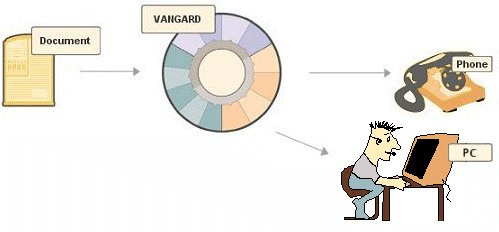VoiceXML:
A Publishing Standard for Accessibility
The
emergence of VoiceXML as an open and widely supported
standard induced a paradigm shift in the voice application
and IVR market by empowering web developers to write
voice applications efficiently. VoiceXML is having a
profound effect on not only IVR and traditional-telephony
applications but also on extending the enterprise and
consumer applications to be accessed by voice. In addition,
VoiceXML is also quietly enabling the disabled to access
applications, services, content, and information in
a usable manner. Using VoiceXML as a document format
for publishing is an effective, inexpensive, and expansive
way to meet accessibility requirements. The VoiceXML
Document Format (VDF) is a self contained W3C compliant,
static VoiceXML file that is delivered through Voice
Web Services's VANGARDTM authoring tool. In general,
publishers may transcode any type of publication such
as books, magazines, news articles, and much more into
VDF files to then be accessed simply by any phone or
computing device.

In
comparison to traditional means of accessibility publishing,
using VoiceXML as an accessible publishing format not
only increases flexibility and usability of the content,
but also decreases costs substantially. The ubiquitous
nature of the telephone and hands-free speech access
provides a highly compelling reason to use VoiceXML
for broadcasting textual content to the disabled community
and for mobile voice access of electronic documents.
Long
documents, complex tables of contents, and the limitations
of text-to-speech technology no longer restrict content
providers from considering new alternatives for accessibility
publishing. VoiceXML's convenience of natural and intuitive
voice commands coupled with the ability to search and
navigate within documents positions VoiceXML as the
standard document format for accessibility to the visually
impaired and the disabled.
Background
Voice
activated telephony deployments are extremely effective
for a large majority of applicable scenarios. However,
in the past, providing speech access to text via the
telephone usually meant inconveniencing the caller with
dialogs that prevented control of the playback of the
content itself. While text-to-speech (TTS) technology
helped voice the written word to the user, the user
interfaces for presenting text audibly was at a considerable
disadvantage compared to presenting text visually.
In
a graphical environment, sighted users have many helpful
features that aid in fully representing the textual
content they choose. However, in a voice only environment,
most text-driven voice applications fail to apply the
features that are so prevalent and useful in a visual
medium such as page scrolling, visual cues, word spelling,
copying and pasting.
Since
developers using VoiceXML rely mostly on TTS technology
to convey content to the user, they have had to also
rely on the TTS software to provide the usability for
playing back the information to the user. Consequently,
Voice User Interfaces (VUIs) designed for presenting
text information to the disabled community lacked the
flexibility to handle large amounts of text information
conveniently and elegantly. The VUI required the user
to either press buttons to arrive at predefined positions
within the content or forced them to listen to the entire
piece without any internal navigation at all. Moreover,
neither the VUIs nor the TTS technology allowed for
useful options such as copying and pasting text or spelling
words through one accessible document format.
Continued...

back
to the top

Copyright
© 2001-2002 VoiceXML Forum. All rights reserved.
The VoiceXML Forum is a program of the
IEEE
Industry Standards and Technology Organization
(IEEE-ISTO).
|

